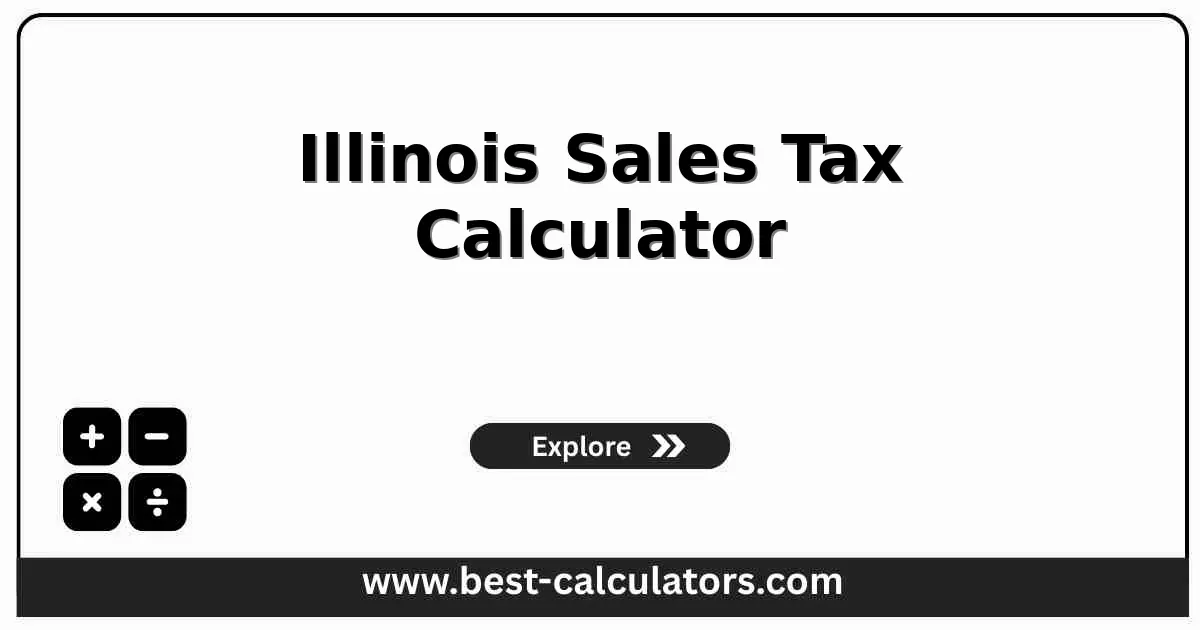Illinois Sales Tax Calculator
Calculate sales tax on purchases in Illinois with accurate 2025 state and local tax rates including the 6.25% state rate.
Purchase Details
Results
What is Illinois Sales Tax?
Illinois sales tax is a consumption tax imposed on retail sales of tangible personal property and some services. With a state rate of 6.25%, Illinois has one of the highest combined sales tax rates in the nation when local taxes are included. The average combined rate is 8.82%, and Chicago reaches 10.25%.
The Illinois Department of Revenue administers the sales tax system. Local jurisdictions including counties, municipalities, and special taxing districts can impose additional taxes. Chicago and Cook County have particularly high rates due to multiple overlapping taxes for transit, public safety, and infrastructure funding.
Compare Illinois rates with other states using our State Sales Tax Calculator, or plan your complete tax strategy with our Federal Income Tax Calculator.
How Illinois Sales Tax Works
State Component (6.25%): This is Illinois's base sales tax rate that applies uniformly across all jurisdictions in the state. It generates revenue for state operations and education.
Local Component (varies): Counties, municipalities, and special districts can impose additional sales taxes. The statewide average is 2.57%, but in Chicago and Cook County, local taxes add 4% to the state rate.
Special District Taxes: Illinois allows multiple special taxing districts for public transit, public safety, and economic development. These can overlap, creating some of the highest combined rates in the nation.
Combined Rate: The total sales tax rate is the sum of all applicable state, county, municipal, and district taxes. Chicago's 10.25% rate includes state (6.25%), county (1.75%), city (1.25%), and RTA (1%).
Key Illinois Sales Tax Concepts
High Combined Rates
Illinois has one of the highest average combined sales tax rates in the United States at 8.82%. Chicago's 10.25% rate is among the highest of any major city, significantly impacting purchasing decisions.
Chicago Premium
Chicago adds significant local taxes: 1.75% Cook County, 1.25% City of Chicago, and 1% Regional Transportation Authority tax. This 4% local component on top of the 6.25% state rate creates the 10.25% total.
Reduced Grocery Tax
Illinois charges a reduced 1% state sales tax rate on groceries (food for home consumption), lower than the standard 6.25% rate. However, local taxes may still apply to groceries in some jurisdictions.
Multiple Overlapping Taxes
Illinois allows counties, municipalities, and special districts to levy sales taxes simultaneously. This creates complex rate structures where multiple local taxes can stack on top of the state rate.
How to Use This Calculator
- Enter Purchase Amount: Input the pre-tax price of your purchase in dollars.
- Select Local Tax Option: Choose "Average" for the statewide average (2.57%), "Chicago" for the Chicago rate (4.00%), "State Only" for just the 6.25% state rate, or "Custom" to enter your specific local rate.
- Custom Local Rate (Optional): If you select "Custom," enter your specific local tax rate. Check your municipality's website for the exact rate.
- Calculate: Click "Calculate" to see your total amount including all taxes, with a detailed breakdown.
- Review Results: View the state tax, local tax, total tax rate, and final amount you'll pay.
Benefits of Using This Calculator
- Accurate High-Rate Calculations: Account for Illinois's high combined rates before making purchases.
- Location Comparison: Compare costs between Chicago and suburban or downstate locations with lower rates.
- Budget Planning: Factor in high sales taxes when planning purchases, especially large items in Chicago.
- Business Compliance: Retailers can verify their tax calculations across Illinois's complex multi-jurisdictional system.
- Cost Awareness: Understand the impact of 10%+ sales tax on major purchases in Cook County.
- Instant Results: Get immediate calculations without manual math or spreadsheets.
Factors Affecting Illinois Sales Tax
- Location: Your county, municipality, and special districts determine the local tax component, with Chicago and Cook County having the highest rates.
- Product Type: Groceries are taxed at 1% state rate, prescription drugs are exempt, and most other goods are taxed at full rates.
- Multiple Districts: Overlapping county, municipal, transit, and special purpose district taxes can create rates exceeding 10%.
- Cook County Premium: Cook County and its municipalities have significantly higher rates than most downstate Illinois locations.
- Online Purchases: Remote sellers must collect Illinois sales tax based on the delivery address, including all applicable local taxes.
- Services: Many services in Illinois are not subject to sales tax, though some specific services are taxable.

Frequently Asked Questions
What is the Illinois state sales tax rate in 2025?
Illinois has a state sales tax rate of 6.25% as of 2025. This base rate applies statewide to most retail sales of tangible personal property.
What is the total sales tax rate in Illinois?
The total sales tax rate in Illinois varies by location. With the 6.25% state rate plus an average 2.57% local tax, the average combined rate is 8.82%, one of the highest in the nation. Chicago's rate is 10.25%.
What is the sales tax rate in Chicago?
Chicago has a combined sales tax rate of 10.25%, which includes the 6.25% state rate, 1.75% county rate, 1.25% city rate, and 1% regional transportation authority tax.
Does Illinois charge sales tax on groceries?
Illinois charges a reduced 1% state sales tax on groceries (food for home consumption). Local taxes may also apply. Prepared foods and restaurant meals are taxed at the full rate.
Is clothing taxable in Illinois?
Yes, clothing and apparel are subject to Illinois sales tax at the full combined rate. Illinois does not offer a clothing exemption.
What cities in Illinois have the highest sales tax?
Chicago and many suburbs in Cook County have the highest sales tax rates in Illinois, with combined rates reaching 10.25% or higher due to state, county, municipal, and special district taxes.